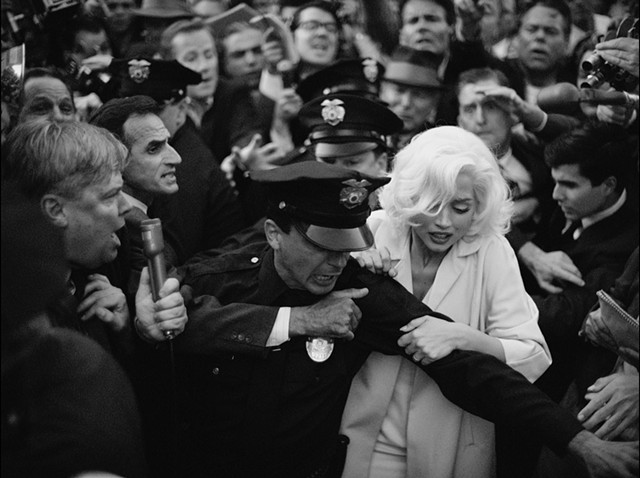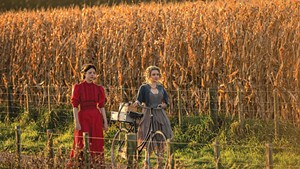
- Courtesy
- De Armas plays Marilyn Monroe as a walking wound in Dominik's controversial riff on her legend.
Netflix's new Marilyn Monroe movie has provoked strong reactions. Manohla Dargis of the New York Times expressed relief that Monroe herself didn't have to sit through Blonde, "the latest necrophiliac entertainment to exploit her." Camilla Long of Air Mail called it "a shocking, ugly, traitorous movie — nearly three hours of shrieking abuse."
Directed by Andrew Dominik, Blonde is not a Monroe biopic — as some might assume — but the adaptation of a 2000 novel by Joyce Carol Oates, whose imagination leans to the gothic. With that firmly in mind, as someone with a high tolerance for drama and trauma, I decided to experience this supposed three-hour abuse marathon for myself.
The deal
In a shabby Los Angeles apartment in 1933, an unwed mother (Julianne Nicholson) gives her young daughter (Lily Fisher) a photo and announces, "Norma Jeane, that is your father." This image of a glamorous stranger will become Norma Jeane's lodestar, haunting her throughout her life — as she loses her mother to mental illness, endures neglect, and grows up into a pinup girl, a movie star and finally an icon of confident, carefree sexuality: Marilyn Monroe (Ana de Armas).
But inside this woman who is desired by men the world over is a frightened child still seeking the daddy she never found. Marriages to a famous athlete (Bobby Cannavale) and a brainy playwright (Adrien Brody) fail to fill the gap. As Norma Jeane buckles under the weight of her own celebrity, letters from a mystery correspondent who claims to be her father become her lifeline.
Will you like it?
If Blonde were our only source of information about the historical Monroe, that would be a problem. But it's not. Keeping in mind that there's no dearth of books and documentaries about the star, I watched the movie not as an authoritative depiction but as an artist's (or two artists') fictionalized riff on the life of a celebrity.
And what a show-offy riff it is. Dominik never for a second lets us forget that we're watching a movie. He switches from spectral black-and-white to glossy color to desaturated color and back; he messes with the aspect ratio. He uses impressionistic digital effects to put us inside Norma Jeane's increasingly paranoid mind: Her husband's face blurs; a cheering crowd of men become distorted ghouls.
The whole movie is a fever dream, fueled by Nick Cave and Warren Ellis' synthy score and de Armas' unsettling performance. She deftly plays Monroe as an icon of anxiety, an abuse survivor constantly flinching in expectation of another blow.
Early on, young Norma Jeane watches in helpless terror as her unhinged mother drives them straight toward a wildfire in the Hollywood Hills. In this version of her story, Norma Jeane never stops being that child, mesmerized by the flames that will eventually burn her alive. Sensuality is simply the armor that she wears to hide the damage within.
And there's so much damage, from a horrifying bedroom scene with John F. Kennedy to an equally disturbing abortion scene that has led Planned Parenthood to condemn the film as anti-choice propaganda. But this is a story with a highly unreliable narrator. When Norma Jeane's fetus speaks to her in a voice that could belong to her own younger self, the conversation feels like a concoction of her deeply troubled imagination.
Blonde is less about the real Monroe than about the mythos that has grown from her story in the collective imagination. In that way, it resembles Baz Luhrmann's Elvis, another fever dream that couldn't pause the nonstop spectacle long enough to let its subject feel like a real person. Both movies portray their subjects as victims — martyrs, even — of their own fame. Both also feature lines of dialogue that no human being could speak with a straight face.
There's something undeniably compelling about these lurid pseudo-biopics, which feel like ambivalent meditations on America's relationship with the concept of celebrity. Over nearly three hours, however, Blonde becomes a chore to watch, as we realize Norma Jeane will never evolve past being a walking wound.
The movie reminds me of the problem that Leslie Jamison posed in her 2014 essay "Grand Unified Theory of Female Pain," which examines the enduring appeal of suffering heroines in art and literature. Granted that pain is a common female experience, she asks, "How do we talk about these wounds without glamorizing them? Without corroborating an old mythos that turns female trauma into celestial constellations worthy of worship?"
Blonde can't answer that question. But the film is such a self-consciously extreme, borderline-campy embodiment of the mythos Jamison dissected that it may prompt us to seek answers of our own.










Comments
Comments are closed.
From 2014-2020, Seven Days allowed readers to comment on all stories posted on our website. While we've appreciated the suggestions and insights, right now Seven Days is prioritizing our core mission — producing high-quality, responsible local journalism — over moderating online debates between readers.
To criticize, correct or praise our reporting, please send us a letter to the editor or send us a tip. We’ll check it out and report the results.
Online comments may return when we have better tech tools for managing them. Thanks for reading.